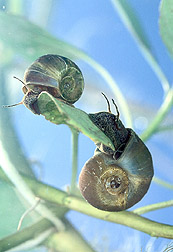This page has been archived and is being provided for reference purposes only. The page is no longer being updated, and therefore, links on the page may be invalid.
|
Read the magazine story to find out more. |
Snail Treatment Reduces Fish Disease in Commercial Production PondsBy Jim CoreSeptember 4, 2002 A new treatment against a freshwater snail that carries a deadly fish parasite reduces the threat of the parasite to farm-raised channel catfish nationwide. Infected fish develop small cysts in their flesh, often seen as bumps just below the skin. The disease can kill smaller fish and reduces growth among infected fish that survive. Currently, there is no cure. Andrew J. Mitchell, a fishery biologist at the Agricultural Research Service's Harry K. Dupree Stuttgart National Aquaculture Research Center in Stuttgart, Ark., found that if he could reduce the vector, he could control the disease. Mitchell's treatment is a shoreline application of copper sulfate and citric acid to production ponds. The formula is applied in the waters around the pond's edge, where the snails live. The concentrated treatment kills the snails, but dilutes as it disperses throughout the pond so it does not harm fish. The parasite is Bolbophorus confusus, a flatworm found in the intestinal tract of the American white pelican, a migratory, fish-eating bird found throughout the United States and in the lower Mississippi River Delta during winter months. Flatworm eggs are released into catfish ponds, where they hatch and form larvae that infect an intermediate host, the rams-horn snail, Planorbella trivolus. When the larvae mature in the snail, they are released as larval trematodes called cercaria that infect fish. The cycle begins again when the fish are eaten by pelicans. Reducing the rams-horn snail population breaks the parasite's life cycle midway through its development. The parasites cannot be transmitted from one fish to another. More than 90 percent of snails were killed in studies. The shoreline treatment is approved for use by the Environmental Protection Agency, and it is being widely used in the Mississippi Delta area. Copper sulfate is already commonly used to curb the growth of nuisance algae in fish ponds. ARS is the U.S. Department of Agriculture's chief scientific research agency. More information on the research is in the September 2002 issue of Agricultural Research magazine. |

